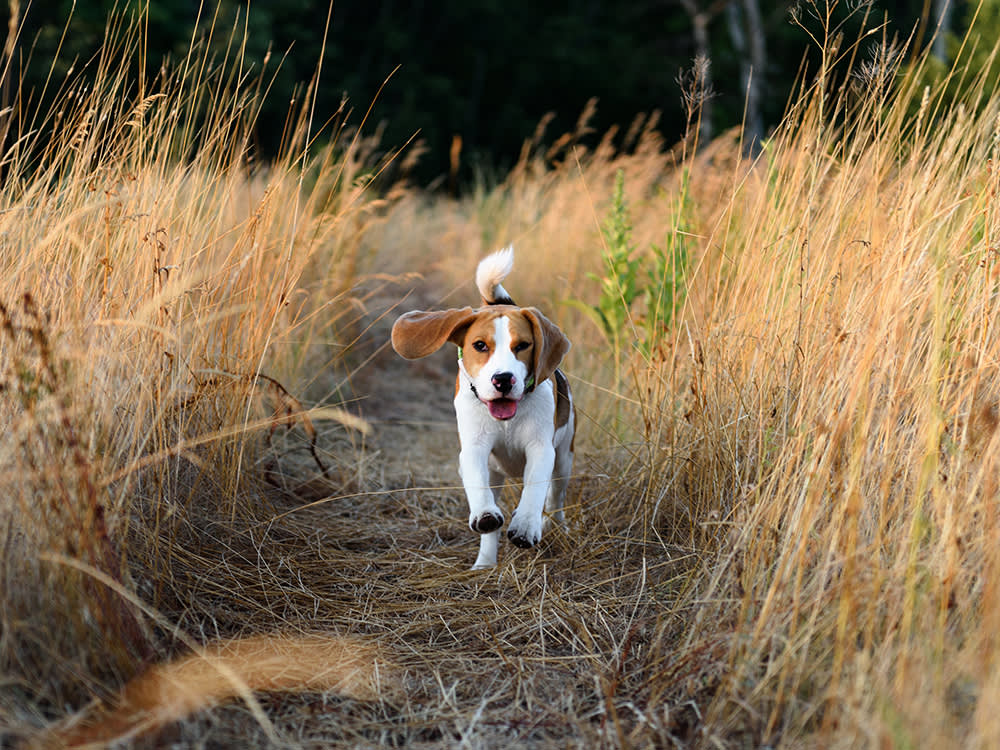The Danger of Foxtail Seeds for Your Dog
How to keep your pup safe during the spring and summer foxtail season.
Spring, unfortunately, kicks off the beginning of foxtail season (and the painful vet bills that accompany it). If you are unfamiliar with foxtails, lucky you. Foxtails, a longtime scourge on the West coast, can now be a problem in every state. And, as if we didn‘t have enough issues with climate change, it may make the wild grass even worse for dogs: Studies find that weeds grow faster under elevated atmospheric carbon dioxide, migrate northward, and are less sensitive to herbicides.
Types of Grasses with Foxtail Seeds
So why are these annual grasses so dangerous to dogs? It all begins with a jagged seed: Of the many kinds of foxtails, only some have harmful barbs. Among them: foxtail barley, found nationwide except in the South Atlantic and Gulf Coast states, according to the U.S. Forest Service; Canada wild rye, bristlegrass, cheatgrass; giant foxtail; and ripgut brome, named for its effects on livestock.
Snap a pic of your pup’s teeth, and GREENIES™ will help you spot potential signs of oral health issues.
The season often starts in May, when the green, bushy grass awns turn brown and seeds disperse. Their spikes help them burrow into soil or dig down into animals‘ fur and puncture skin. The foxtail, which carries bacteria, may then keep tunneling into tissue, carving the dangerous path of infection that marks grass awn disease.
The Danger of Foxtail Seeds
Once the plant heads dry, they become hell-bent on finding their way into dogs’ noses, ears, eyes, mouths and just about every other orifice. They can dive deep into a dog’s nostril or ear canal (beyond sight) in the blink of an eye. And a foxtail camouflaged under a layer of hair can readily burrow through the skin (a favorite hiding place is between toes).
How much do you spend on your pet per year?
Foxtails can wind up virtually anywhere in your dog‘s body, and associated symptoms vary based on location. For example, a foxtail within the ear canal causes head shaking; under the skin leads to a draining tract; or within the lung, labored breathing and coughing. Not only is the dog’s body incapable of degrading or decomposing foxtails, but these plant awns are barbed in such a way that they can only move in a “forward” direction.
Unless caught early, they either become walled off to form an abscess or migrate through the body causing infection and tissue damage. Once foxtails have moved internally, they become the proverbial needle in a haystack — notoriously difficult to find and remove. Sometimes a foxtail lodges and causes a localized infection. But when it migrates, its barbs keep it moving on a one-way journey to almost anywhere — even the brain. Organs can be pierced, fungal infection can arise, and bacteria pack an extra punch deep inside the body. Head shaking or muscle movement propels it onward. Breathing can draw it further into nasal passages. Inhaled foxtails can travel from the nasal cavity to the lungs — a common site in working field dogs.
Identifying Mean Seed Migration
The grass awn migration disease is very difficult to diagnose, says University of Wyomingopens in new tab botanist William K. Lauenroth, who studied its occurrence in ten Midwestern states, where field dog owners believe there’s been a sharp rise in cases. One reason it’s hard to pinpoint is that the infection occurs behind the migrating seed. Many infections show up as an acute illness, according to the findings of Wisconsin resident Cathy Lewis, whose website meanseeds.comopens in new tab provides case histories and information about foxtails and grass awn disease.
In 2013, Lewis’ Springer Spaniel developed a mysterious respiratory ailment that required draining fluid from his lungs. It began during an outing in January — not the time of year when foxtails come to mind. In fact, no plant material was found to confirm the dog’s condition. But Lewis has had several other dogs with grass awn infections and recognized the signs, however vague. Today her dog is “doing fine,” Lewis says. “He’s back to running field trials and placing.” That may be due to how quickly she acted on his symptoms: labored breathing, high temperature, and lethargy.
Where Are Foxtails Found?
The pesky, bristly foxtail plant awns grow in abundance throughout California and are reported in most every state west of the Mississippi. Sporting dog parents may know foxtails best since field dogs routinely charge into thick brush, where they easily inhale or swallow foxtails, and spend hours in grassy hotspots. But dogs playing in the park or yard, hiking, at a roadside stop; any dog, wherever foxtails live, can develop grass awn migration disease.
But what about the urban hound or beach bum pup? One study of grass awn migration found the most common site for foxtails in all dogs was the external ear canal. Others were feet, eyes, nose, lumbar area, and thoracic cavity. Warning signs, if any, include extreme sneezing, head-shaking, coughing, excessive licking of a skin puncture, and a high temperature.
Lauenroth, who trains retrievers, pursued the matter with a grant from the AKC and sporting dog groups. They suspect barbed grasses, especially Canada wild rye, planted in the U.S. Department of Agriculture’s Conservation Reserve Program, have caused more cases. The grasses occur on lands where field dogs train and trial. The program pays farmers to let idle cropland provide ecological services, such as erosion control and wildlife habitat. The farmers plant approved native grasses and comply with mowing restrictions.
Lauenroth found that plenty of Canada wild rye has been planted in the Midwest, and its sharp awn makes it dangerous for dogs. Canada wild rye is also common along the east coast, he says. But the study dried up due to a dearth of definitive diagnoses to draw on. For vets, finding a foxtail seed in a dog is like searching for a needle in a haystack. Lauenroth says he was unable to extract numbers of cases over the past 20 years from the records of veterinary hospitals. What he found were many “foreign body” cases without resolution. Many of those may have been grass awn disease. A study in 1983 found that grass awn migration in dogs and cats accounted for 61 percent of all foreign body-related cases. Most involved dogs.
Preventing Foxtail Seeds Problems
To make foxtails more visible, vets often suggest giving dogs a close shave called a foxtail haircut. Others swear by headgearopens in new tab that protects your pup: foxtail hoodiesopens in new tab, designed to keep mean seeds out of eyes, earsopens in new tab and mouths.
Lauenroth’s advice is to thoroughly brush and comb after outings. The seeds don’t instantly disappear into the body. Also, get to know the few dangerous grass plants in your area. In foxtail zones like California, it can also mean getting to know other dog owners: many outings at park and beach end with a not-so-festive foxtail-pulling party.
If you suspect your dog has a foxtail-related issue, contact your veterinarian right away to find out what steps can be taken (at home or in the veterinary hospital) to rid your dog of this unwanted plant material. Whenever possible, avoidance of foxtail exposure is the best and only foolproof prevention. If your dog does have access to foxtails, carefully comb through their fur— checking ears and toes, too — a couple of times daily to remove any that are embedded.






